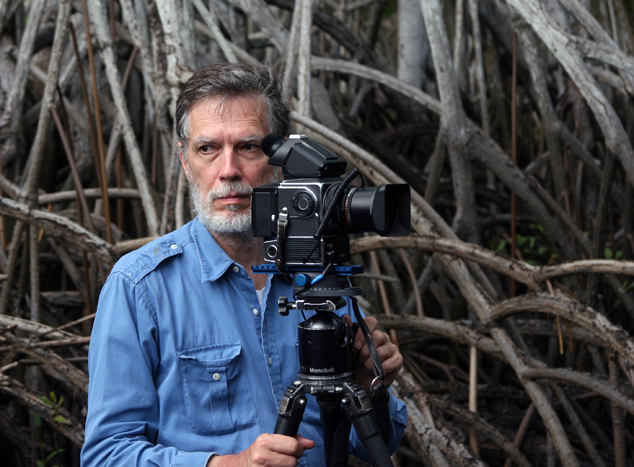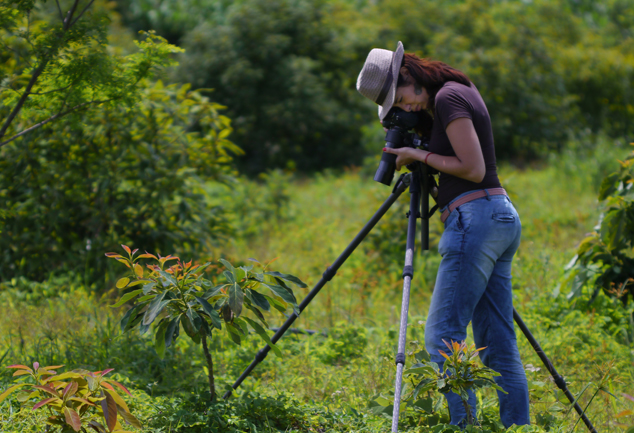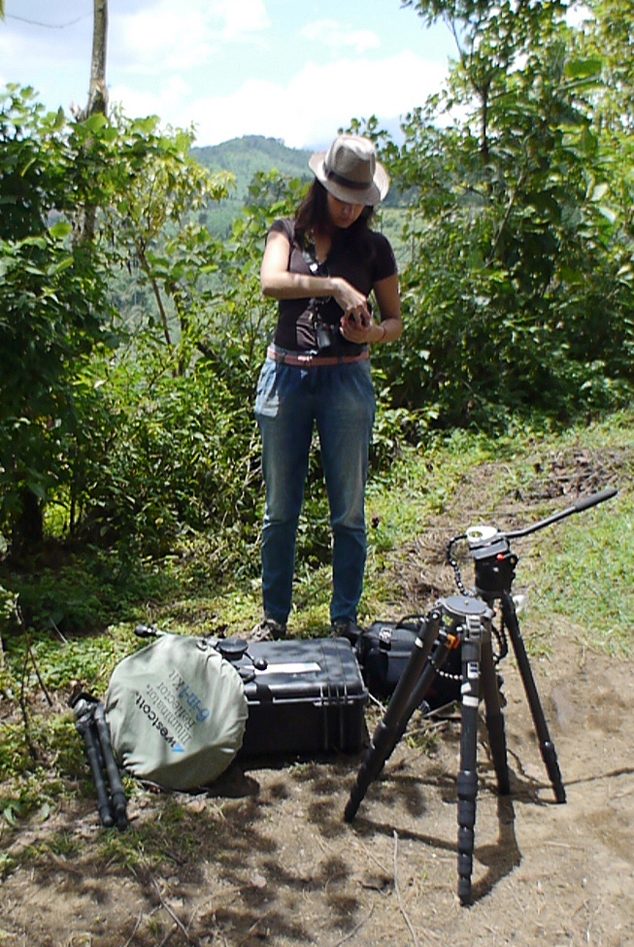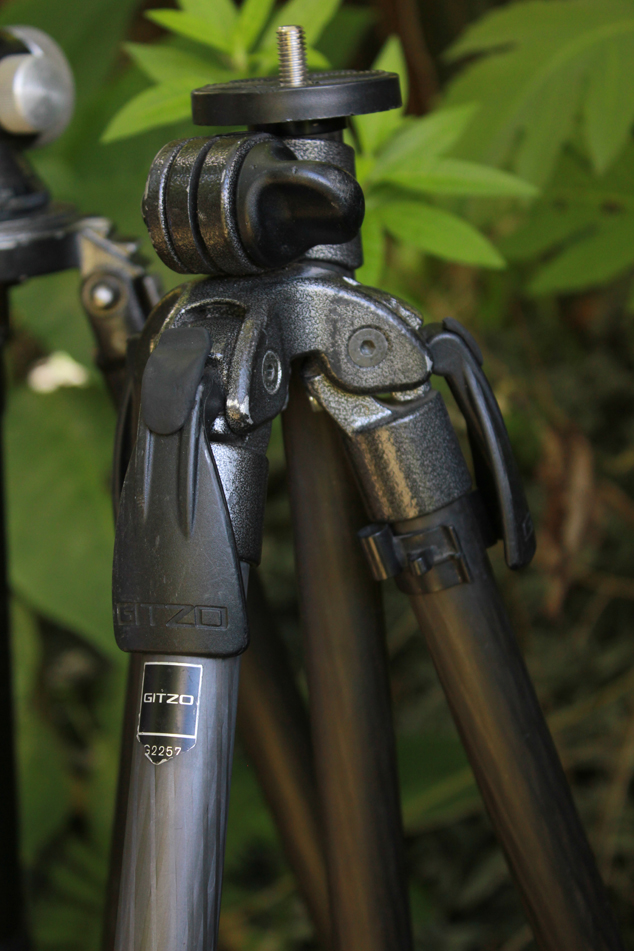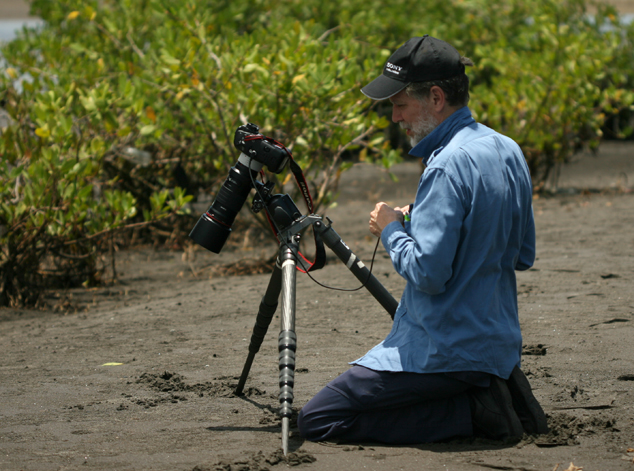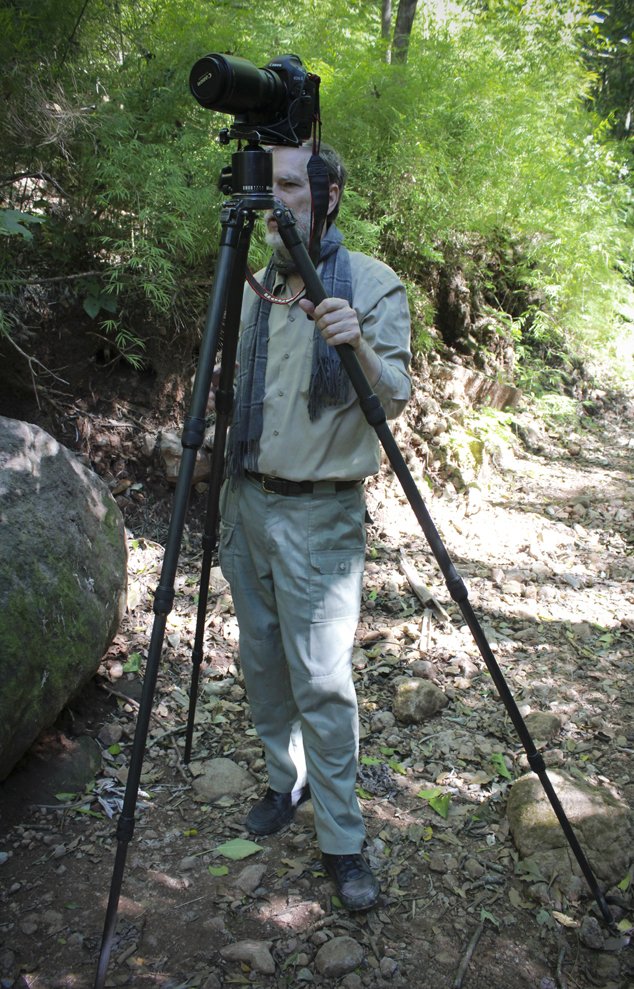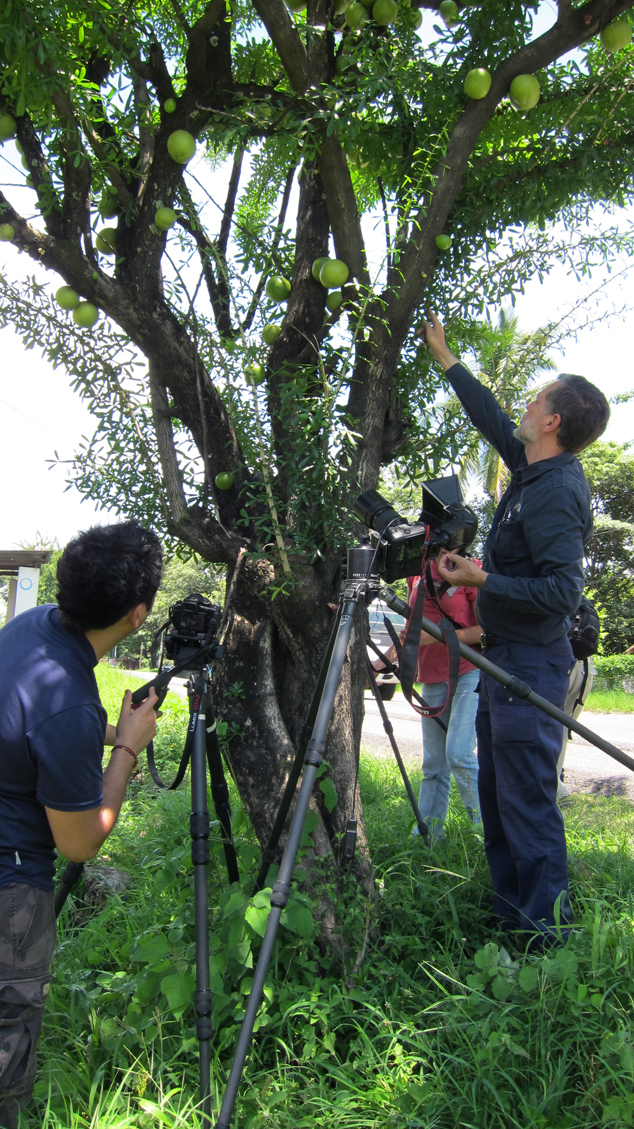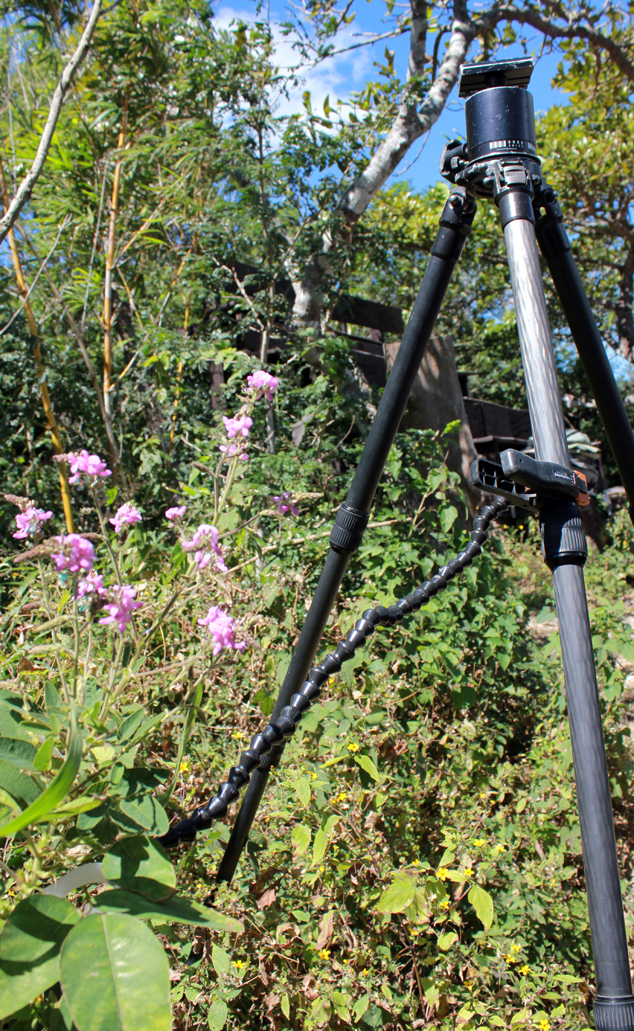Perhaps 2% were taken with a Manfrotto tripod.
About 4% were taken with no tripod at all.
Nicholas taking pictures with a Gitzo G1348 MK2 Mountaineer Inter-Pro Studex tripod + Arca-Swiss tripod head + Hasselblad with a Phase One P25 digital back + Novoflex rail. Mangrove swamp near Monterrico, Guatemala, 100 meters from the Pacific Ocean coast.
If you notice that the photographs of flowers, plants, trees, fruits and vegetables on this web site are a bit better than photographs on many other botanical web sites, it is because we
- Use a tripod
- Usually usea a cable release
- Use good lighting (reflectors or flash outside; Westcott digital fluorescent in the studio)
- We have the lighting come from the best angle possible
- We take the time to seek a photogenic situation
- We have as a goal to do more than just-take-a-photo
- On the Hasselblad Zeiss lenses, always do a mirror pre-release lock-up
The other reason is probably that FLAAR Reports has over 42 years experience of photography in Guatemala, Mexico, Belize, and Honduras.
The purpose of our pages on digital photography are to give to botanists, ethnographers, and archaeologists the benefits of our experience. Many capable photographers understandably don’t want to tell competitors their secrets. But FLAAR is a non-profit institute and our goal is to share what we know.
This new web page is also available as a PDF; the PDF version has many more photographs (that would not fit on a single web page). The reason for this new web page (and the PDF) is that we visited PhotoPlus camera equipment expo for several days in New York this autumn, and felt it would be helpful to photographers if we wrote our evaluation of the tripods that were being offered by manufacturers compared to our 40+ years of experience using tripods.
The purpose of this FLAAR evaluation is to assist photographers to make their decisions.
Why use a tripod at all?
Thousands of photographers achieve gorgeous photographs with no tripod. But I use a tripod for close to 98% of my shots if I have a tripod available. My assistants are being trained to use tripods as well, but this takes practice and patience to get them to swith to using tripods.
The only time I don’t use a tripod is when a special permit is required (such permits are ridiculously expensive and since FLAAR rarely sells our photos, we are not making money from our photography).
When non-tripod users are questioned about why they don’t use a tripod, most say that a tripod ties them down. You can be more spontaneous without a tripod. Yes…, but once you get accustomed to having a tripod always, you will develop spontaneity with the tripod.
Jennifer Lara photographing avocados plants using a Gitzo G2257 Explorer tripod. Parramos Guatemala 2011.
I once went on a field trip to photograph the colorful doors and window shutters on a Greek island. The person with me said “I don’t need a tripod because my Canon camera lenses have stabilization, etc, etc.
At the end of the trip, after he saw my photos, and compared them with his photos, he said, “Now I see why you use a tripod.” In other words, lens stabilization is better than none, but lens stabilization is NOT enough to beat using a tripod.
But, when is using a tripod not a good idea?
If your tripod is cheap, wobbly, or in whatever way inadequate, this can diminish the quality of your photos.
And, if you don’t use a cable release, your finger will cause shake (even if the camera is on a tripod).
The most common problem I see in young photographers is that they never use a cable release and their legs, arms, hands, and fingers are totally entangled with the tripod.
But, when is using a camera tripod not a good idea?
If your tripod is cheap, wobbly, or in whatever way inadequate, this can diminish the quality of your photos.
And, if you don’t use a cable release, your finger will cause shake (even if the camera is on a tripod).
The most common problem I see in young photographers is that they never use a cable release. And their legs, arms, hands, and fingers are totally entangled with the tripod. So they are shaking their tripod and causing the camera to move even when the use a tripod.
No, that is the wrong way to use a tripod. MOVE AWAY from your tripod. Never be anywhere near your tripod. Use a cable release so there is no excuse even to touch your camera.
To achieve better photographs
If you are only sending photos to family and friends, you probably can do without a tripod, since few will notice the difference. But if you wish your photos to stand out, and if you ever intend to enlarge them, be sure to
- Have a solid tripod that does not wobble.
- A raised center post is the most common cause of wobble. Most of my Gitzo tripods deliberately don’t even have a center bar.
- Use a cable release.
- Use a mirror-lockup mode for taking each photograph.
- Keep your hands and body away from the tripod while you take your photograph.
Jennifer Lara preparing cameras and Gitzo G1348 MK2 Mountaineer Inter-Pro Studex, Gitzo G1127 and Gitzo G1548GT tripods to photograph avocados fruits. Parramos Guatemala 2011.
Gitzo tripods
In North America, we tend to do photography in the Ozark Mountain area. So we may be photographing on a hillside, or in a creek. Thus the Gitzo tripod ability to move its legs to any position is essential.
In Guatemala we are also doing digital photography in rough terrain, so the ability of a Gitzo tripod to put its legs down, or sideways, is crucial. Once you have used a tripod with this capability, you would never accept any lesser brand or model.
Gitzo G2257 Explorer tripod. FLAAR Photo Archive.
Which tripods does FLAAR use already?
Our first tripod, a Tiltall, was great when I was in college, but once I went pro, I jumped to Gitzo. My photos that were published by National Geographic back in the 1970’s were all taken with a Gitzo tripod. And since then I have another 40+ years more experience with many other Gitzo and one Manfrotto tripod.
My first Gitzo, although at pro level, was not perfect forty years ago, and their then US distributor was not as hospitable and helpful as is Manfrotto Distribution today (Manfrotto Distribution is the rebranding of Bogen Imaging). So that early model is long ago replaced by more robust and longer-lasting Gitzo tripods.
Not one of my Gitzo pro-level tripods since then has worn out: one had a leg broken when the leg was stuck over a meter deep in muck at the bottom of a crocodile-infested swamp near the Pacific Ocean coast in a mangrove area. We were doing large-format panorama photos of the sacred water lily there, and when we tried to pull the tripod out of the deep mud the leg got stuck and the assistant, moving the tripod back and forth, cracked the leg at the support.
This was his fault, and not a defect of the tripod.
Here are some of the Gitzo tripods we have experience with. Several of these are models which are no longer made, so we hope to get more current models so that we can evaluate models that are available today.
There are seven in our full photo team, and each size and kind of camera and lens works best with a different tripod.
- Gitzo G1504 MK2, the weight is an asset as a studio tripod. Has G528 geared center column.
- Gitzo G1127 MK2, lightweight and perfect low height, great for traveling out on location
- Gitzo G2257 Explorer, carbon fiber tripod; unique “clasp” locking system at top
- Gitzo G1548GT, ideal for my Hasselblad and Phase One
- Gitzo G1501 MK2 Tele Studex, (probably the one damaged by assistant in the crocodile swamp)
Nicholas photographing hermit Crab with a Gitzo G1348 MK2 Mountaineer Inter-Pro Studex tripod + Arca-Swiss tripod head + Hasselblad with a Phase One P25 Digital Back + Novoflex Rail. Mangrove of Monterrico 2010.
What new tripods would we like to evaluate?
We photograph:
- Mayan archaeology artifacts
- Architectural history (in China, Thailand, Guatemala)
- Giant jungle trees, sacred flowers of the Maya, tropical fruits, curious vegetables of Central America
- Insects, spiders, scorpions: jaguars, crocodiles and howler monkeys; vultures, herons, macaws; crabs and shellfish
So it helps to have really really tall tripods (for flowers up in trees) and really low tripods for insects under rotting logs, and mid-sized tripods for normal photography. Especially since there are several excellent photographers on our staff, and since we each are doing a different subject with a different camera, it helps to have a diverse range of tripods.
For intermediate level photographers it would help to evaluate something a bit higher than the nice Gitzo G1227 so perhaps a Gitzo GT2542L or GT2531. I must admit that I prefer the traditional top click positions of the leg latch (the old-fashioned Gitzo innovation from the original French company).
For really showcasing what a Gitzo can do (and what you won’t get from a lesser brand), we would like to evaluate the fllowing from December onward:
Gitzo GT5561SGT with GS5510XLS Telescopic center column
or,
GT3541XLS, “Extra long tripod” with GS5510XLS Telescopic center column.
or
GT5561SGT, “Giant Tripod” with GS5510XLS Telescopic center column. This we would use when photographing tropical fruits or flowers that bloom only high up in trees. We bring a ladder along with us on all field trips. We sure could publish remarkable photographic results if we had a tripod like this.
Gitzo GT3320BS, “baby tripod” since we photograph insects on the ground, such as leaf-cutting ants (especially when they are harvesting flowers).
Caption (Rio Dulce recent trip, or Sayaxcha earlier this year): Here is Nicholas photographing ants on the ground.
Comments: which tripods features to skip:
Every photographer will have their favorite features and accessories. So what I will now discuss are my personal preferences. But you may be photographing under other conditions. For example, if you are primarily in a studio, then you don’t have to worry about transporting your tripod weight around the world.
If you are only photographing outside but still in your own local area, then you will not have the issues we do: mangrove swamps, climbing up and down mountains, or out in remote rain forests.
If you take your tripod out on field trips, I suggest all tripods be without a wind-up handle. Any handle is just one more item to snag, break off, or otherwise become a headache. A handle is not needed (I have had National Geographic publish my photos taken with Gitzo tripods with no handle!).
Flip-locks for changing the angle of the legs are a real pain, especially when at the top of the tripod leg. This is why I only use Gitzo tripods and no longer any system that has a flip-lock at the top. The Gitzo system allows you to move the legs to many positions without having to flip, lock, or unlock anything. You only need to pull the clasp out at the start of the day if you think you will later need to put the leg into an extreme horizontal position.
Why is a locked-leg-position-system-a-headache? Because not many assistants will take the time to bother to flip up the lock to move the leg angle. They will simply force the leg (leaving the lock clamped). Of course this wears out even a well made lock.
All this is one reason I much prefer Gitzo tripods.
Nicholas photographing pochote with a Gitzo G1348 MK2 Mountaineer Inter-Pro Studex tripod + Arca-Swiss tripod head + Canon EOS-1D Mark III. San Salvador 2011.
Gitzo tripod accessories
You can opt for a spike at the end of your tripod supports (to get into the soil). You can opt for a wide foot (especially for a monopod, but probably usable for tripod as well?). There are plenty of accessories both for Gitzo and Manfrotto tripods. I tend to be Spartan and not use too many accessories (they either get lost, or get left in the main studio: I have drawers filled with equipment accessories from past years; who knows even for what equipment they were original made for a decade ago).
But there are several accessories that I recommend. I discuss these in our separate page on tripod heads.
Manfrotto tripods
My first professional tripod (for my first Hasselblad) was a Gitzo and today, over 40 years later I am still using Gitzo. From Manfrotto it is mainly their tripod heads that I use: my favorite is their large geared head, today the model 400. But Manfrotto also makes tripods. You can see these Manfrotto tripods at Photo Plus expo in New York every year, and at Photokina.
FLAAR staff photographing morro or jícara (Crescentia alata, Crescentia cujete) using Gitzo and Manfrotto tripod and tripod heads. FLAAR Photo Archive.
NOVOFLEX QuadroPod “tripod”
There are several things that you will like about the NOVOFLEX QuadroPod. First, it is innovative. I don’t know of anything like a four-support tripod elsewhere.
Second, the NOVOFLEX QuadroPod is a complete system: it has a clever range of accessories. Someone spent a lot of time cogitating on how to offer a solution for every imaginable situation.
Here at FLAAR we go out photographing in swamps and mountains of Central America. We are in rain forests to deserts (yes, there is also a desert (called a dry forest in technical terms) in Guatemala; even has a Gila Monster relative; very venomous, the Motagua Valley beaded lizard, Heloderma horridum charlesbogerti). So a tripod with the ability to do many things is something we look forward to testing.
NOVOFLEX has a six page catalog on the QuadroPod: there are that many accessories, to fill all the pages.
For the PDF version of this page, also use photos possibly from Photokina 2006 and 2008, and maybe 2010
What about other brands of tripods?
I prefer to avoid tripods made in China since the one we bought fell apart after a few months of use. Actually it was a Sony brand, but it was so rinky-dink I assume it was made in China. It was bought in haste by someone else at my office.
Surely there are other Chinese-made tripods that hold up better, but why waste your time and money if you are unsure. Gitzo makes every size and shape of tripod I could possibly need. Even KIRK enterprises features Gitzo tripods. NOVOFLEX makes their innovative QuadroPod.
But if a tripod from another brand lands in my mailbox I will be glad to try it out, but it will be tough to beat Gitzo. However no tripod is perfect, and for every x-thousand tripods made even popular brands will have an occasional bad egg.
The legs on a Gitzo can he put in almost 180° position, so if you are on a steep hill you can put one leg straight out against the rise of the hill.
You can get a Gitzo with no center column; a center column on a cheap tripod is often a focal point for wobble.
But, if you need a center column, you can opt for one on a Gitzo tripod. What I really like is that it extends up several levels! I saw this in Paris or somewhere recently (on a Gitzo tripod).
In today’s world, there is not much need to limit yourself to a Linhof tripod, and Sinar did not even exhibit at PhotoPlus (so their associate brand of tripod was not visible). Ten years ago, Sinar usually had the most exciting booth at Photokina. Although a Swiss or German tripod should be well engineered and long-lasting, so far I have never felt any particular need for one. Perhaps if I had a Linhof tripod I would never use anything else! But I am fully content with my Gitzo tripods.
Wimberly plamp + Gitzo G1348 MK2 Mountaineer Inter-Pro Studex tripod + Arca-Swiss tripod head. FLAAR Photo Archive.
Final comments on tripods
If you have any tripod which is good, and if you get accustomed to it, you will be content. So if you take a dozen different photographers, they will not all like the same tripod. But when I run into professional photographers around the world, they tend to use Gitzo tripods, both out on location, and in the studio.
Appendix A
Comments on our tripods in our field office
- Gitzo G1504 MK2, ideal weight to serve in your studio (G528 geared column)
- Gitzo G1127 MK2, great for traveling
- Gitzo G2257 Explorer, carbon fiber tripod, with flip-style leg locks.
- Gitzo G1348 MK2 Mountaineer Inter-Pro Studex Tripod
- Gitzo G1548GT, very good for full-size Canon, Nikon or medium format digital camera
Gitzo G1504 MK2
This trusted companion has its heavy weight as an advantage. Yes, having a heavy tripod is helpful if you face strong winds. This is definitely not a carbon fiber tripod!
The heavy weight of the G1504 MK2 is a definite advantage for the studio: less likely to be knocked over by accident. I am fully content with heavy tripods for in-house studio photography. We bring exotic tropical fruits to our studio; insects (we raise butterflies). Plus we have a 4x5” studio camera (with BetterLight digital back). So a heavy tripod is an asset.
It has a wind-up center post. If you need to take your tripod on field trips, I recommend skipping any accessory that has handles, as they are the first thing that someone will knock off, or bend out of shape. But, your style of photography may find a raisable center column is good. Simply Google Gitzo raised center column and you will see Gitzo GS3310GS Series 3 Compact Aluminum Geared Column - Replaces G338 (Grey) and several other comparable results. There is also a Gitzo Series 4/5 Aluminum Long Geared Column For Systematic Tripods GS5310LGS
I have the Gitzo 528 geared center column. Most of our other tripods do not. The advantage of a center post is that you can raise your tripod higher, without having legs that are too long. Legs that are too long will not fit in a suitcase, or require a carrying bag that is too long. So short leg (sections) are an advantage.
Many photographers prefer a center column, and like the geared concept. I tend to be a “column-less” user, but since several different photographers work for FLAAR we try to have a diverse range of equipment for them to select from. When they finish their internship or work period, then they go out and buy their own tripods based on what they learn at FLAAR.
But since we often have to photograph things high in a tree, we need high tripods. We bring ladders with us.
What I especially recommend, if you need to get really high, is the absolute tallest Gitzo tripod, AND, their raisable center post (we do not have this).
If you need a heavy tripod, then you need a heavy tripod. Fortunately Gitzo still makes this class of tripod.
Gitzo G1127
Gitzo G1127 MK2 is perfect when I travel internationally and need only to use my tripods at a printer expo or at Photokina or Photo Plus. I don’t need a larger tripod for photographing at trade shows. The several women photographers on the FLAAR team like this model because it’s lightweight and not four meters high!
The practical size and low weight of the Gitzo G1127 also helps when team members have to carry their own tripods (in other words, when we have only a few native bearers, and thus we each take part of our own equipment). The advantage of having local bearers is that then we can focus on doing our photography rather than being worn out from hauling heavy gear up and down steep karst hills or slippery slopes inside caves. But we do each try to carry the basics, such as camera and our own tripod.
I have used my Gitzo G1127 MK2 so long I do not know whether it is a G1127G or something else. The numbers are worn off past G1127, since we use this tripod all around the world for years. I think there is no “G”.
Gitzo G2257
The Gitzo G2257 Explorer, carbon fiber tripod has a unique “clasp” locking system at top. I am sure this clasp system is enjoyed by some, but it wears out after several years. One reason is because all incoming interns don’t realize you have to lift the clasp up; they simply force the legs into the needed position. Thus personally I much prefer the old-fashioned French-Gitzo system of click-stops at the top. Indeed it is the click-stops at the top that is the reason why I recommend Gitzo tripods. So we hope to replace the “clasp” lock system with a more traditional leg-top lock system.
Gitzo G1548GT
The Gitzo G1548GT is perfect for nature photography because you need to be capable of having the camera at a high level. We almost always carry a ladder with us. For many flowers you want to be above, looking straight down. So you need a tall tripod.
We now have a project to photograph bee nests, wild bees, out in the jungle. The nests are very high up. So we would like to evaluate either additional really tall tripods (since we have several photographers on each field trip).
Gitzo G1348
The Gitzo G1348 MK2 Mountaineer Inter-Pro Studex Tripod has been a great companion for years. I even used to carry this in my suitcase around the world. But now that I travel about 414,000 kilometers a year (over 250,000 miles: quarter of a million miles if my math is right), I will admit that I take the Gitzo G1127 MK2 with me instead. But for field photography of flowers, trees, insects, and birds, the Gitzo G1348 MK2 is an excellent unit.
December 2011 and all 2012 onward we are doing even more photography (since our readership for our reviews keeps going up), so we look forward to having additional tripods to evaluate. People prefer to read about the new models.
We at FLAAR Reports review tripods on several other web sites
For archaeologists and anthropologists, we provide photography tips (for what equipment we recommend) on our www.maya-archaeology.org.
For zoologists we provide information on what equipment is best in a zoo, park, or out in the field on our www.maya-ethnozoology.org.
For all other kinds of photography, especially panorama photography, studio photography, and architectural photography, we put our tripod recommendations on our www.digital-photography.org
First posted November 30, 2011


